 |
surfresearch.com.au
alexander : water sports, 1911 |
| home | catalogue | history | references | appendix |
|
For an earlier, but
briefer, description of surfing in Fiji, see Source Documents:
1900 H. Wilfrid Walker : Surfriding
in Fiji.
Also note the account of rock sliding on Taviuni, Fiji, and Papasaia
in Samoa, pages 559 to 661.
This activity, along with high diving or jumping, is documented in
several accounts from the Hawaiian Islands and was probably widespread
across the Pacific islands.
See Source Documents:
1876 Mrs. Brassey
: Surfriding at Hilo.
1882 Walter Coote : Cliff
Jumping, Hilo.
1886 Walter M.
Leman : Cliff Jumping, Hilo.
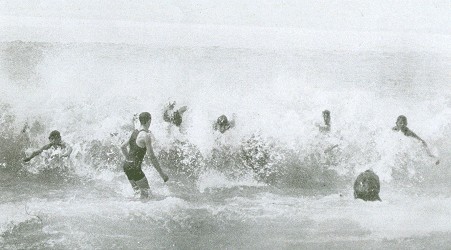 |
|
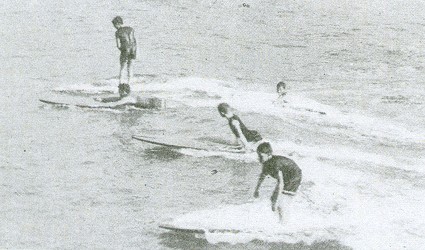 |
probably Waikiki.) Untitled. |
I was lucky enough to be invited to attend a palolo expedition - as soon as the third quarter of the moon came round - for on two days, and two days only, out of every year the palolo makes his apearance in the South Seas.
If you wish to
enjoy the sport of palolo fishing, you must be in Fiji or Samoa during
Octqber and November.
If at the third
quarter of the moon in October, just before dawn, the palolo rises in small
numbers, the native knows that the big catch will be in November; if in
large numbers, he need not bother about the November catch at all; so it
is safest to arrive in these islands about the middle of October, if you
are a palolo enthusiast, and palolo fishing is certainly one of the rarest
sports in the world, confined to two groups of islands, two days at most
out of each year.
There is one reef
near Apia where the palolo is known to rise in vast numbers.
When October
comes, every one watches the moon; on the night that it enters its third
quarter, every man, woman and child, white and native, who can beg, borrow
or steal a canoe or craft of any kind, makes for the reef.
Patiently the
fleet waits, watching the outer edge of the reef where the swells of the
ocean break into foam.
By midnight the
line of foam is well guarded, everyone watch- ...
Page 654
... ing the waters;
in every boat is a scoup of mosquito netting for each occupant; an hour
passes and a few string-like worms of greenish color, some eight or ten
inches in length, float up to the surface of the sea.
Now the excitement
becomes intense - this greenish sea worm is the palolo, that lives for
364 days in the coral; if he begins to come up in large numbers, there
is a great cheering, and the nets are gotten in readiness; if the numbers
are few, there is disappointment and many paddle to shore, knowing that
the great catch will be four weeks later to the day, hour and minute.
But on the day
of the great catch!
About 3 a. m.
a huge sea serpent seems to rise from the sea and stretch its length just
above the irregular edge of the coral bank - a green and yellow writhing
gelatine-looking mass floats upon the sea - everywhere now the spaghetti-like
palolo is rising to the surface - sharks and every kind of fish are swarming
to the reef to enjoy their one great annual banquet.
The occupants
of the canoes do not heed the fish, and the fish ignore them - it is palolo
day - or to be accurate palolo hour, for at dawn these shiny strings of
life will sink again to their holes in the coral - or as the sun rises,
melt away and disappear in the briefest space of time.
With shrieking
and laughter the scoops and nets are dipped into the sea and lifted up
laden with shiny writhing palolo; as fast as the fishers call ply their
arms and nets the lucious sea worms are bailed into the boat, until she
sinks in the sea to her gunwales, and as the great serpent-like line of
green and yellow slime begills to dissolve before the rising sun, the fleet,
heavy laden with the spoil, returns to Apia, where an army of helpers is
ready with pails, buckets, old oil cans and every kind of receptacle to
carry home a portion of the catch.
The children
are hurried into the fields to pick taro leaves, and soon fires are burning
in every house and native hut in Samoa.
The long sea
worms, that smell and taste like oysters, are wrapped in taro leaves and
baked, the crisp ...
Page 655
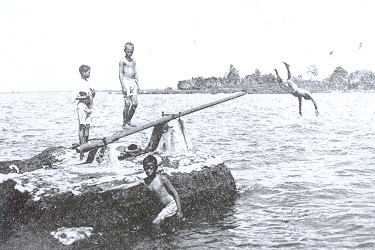 |
Ernest Moses Photo. |
Another sport
upon the reefs that took my fancy was crayfishing.
The crayfish
- as large and luscious as lobsters - live down below the jutting edge
of the outer reef. The natives, who have acquired the difficult art, visit
the reef at low tide, stand upon its edge, and as the wave recedes, dive
down, swim beneath the ledge and look for the crayfish upon the wall of
coral.
Although the
water upon the reef may be but a few inches deep, beyond its edge there
is a drop of hundreds of fathoms.
Here the rollers
that have started near the coast of South America, meet their first obstacle,
and there is a constant roar of the breaking surf.
Let anyone get
caught in this and he is apt to be pounded to death against the coral barrier,
or if not, the back wash may force him beneath the shelving fornlation,
and keep him there until drowned.
It was in this
way that hundreds of sailors lost their lives during the great hurricane
that made Apia historic.
There are native
men and women, however, in these South Sea Islands who have learned to
dive beneath this self of rock; they wait for the psychological moment,
drop over the edge, secure the crayfish, rise again just as the wave has
spent its force, and land in safety.
Usually these
divers wear goggles that fit closely and keep the water out of the eyes,
for they must keep their eyes open to look for the crayfish, and then watch
the crest of the wave above that they may know just when to rise, for it
is a dangerous sport, this crayfishing in the South Sea Islands.
There is one more sport on the coral that to my mind is as thrilling as any on dry land, and that is surfing - whether it be jumping the reef in a cutter before a storm, with one chance in ten that you do not have to swim ashore ...
Page 656
... from the wreck,
or riding in on a surf-board with the thrilling, blood-curdling knowledge
that there are sharks about.
I had learned
to ride the surf-board in Hawaii, and everywhere while cruising among the
Fiji Islands I was on the lookout for native surfers.
No one had ever
heard of surfboard riders in Fiji - everyone ridiculed the idea, save one
old settler I met on the cruise.
He had lived
among the natives for years, sharing in their life and sports.
"On the Island
of Taviuni," he said, "you will find natives who ride the surfboard; it
is the accomplishment of a little village called Korovu, near the end of
the island ,where it joins the reef."
I made for Taviuni,
but no one on the island, not even those who had lived there for years
and decades, knew of any natives who rode upon the surf; in fact, my claim
was ridiculed; but I had seen the great rolling surf at Korovu as we sailed
past, and had made up my mind to have a closer acquaintance.
Two of the planters
were desirous of seeing how the thing was done, so provided horses and
we rode away.
At the little
native village we were met by the Buli, or Iocal chief, "Yes, his people
did ride the surf, but the men who were best at it were away gathering
copra for the trawlers, but if the gentlemen wished it, he would order
some of the women and old men into the sea."
We did wish it,
and soon I was scurrying about seeking a surf-board.
Alas! to my disappointment,
I found that the Fijians, unlike the Hawaiins, use any scrap of timber
as a board for surfing; moreover, they never stand upon their boards, which
are usually but two or three feet in length, being content to merely rest
their chests upon them and come sweeping in before the waves in a prostrate
position.
However, I succeeded
in finding a piece of an old canoe, some seven feet in length, and determined
to make an attempt that if successful would, I was certain, astonish the
natives.
We started for
the surfing place.
It ...
Page 657
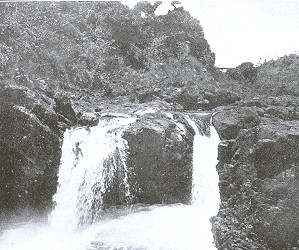 |
Ernest Moses Photo. |
Page 658
... ing me not
only backward over the edge of the reef, but downward, for a Niagara poured
over the reef with each receding wave.
I leaped from
my board and stood upon my feet almost on the edge of the reef, the backward
swirl caught me in its grasp and bore me down, tearing my feet upon the
sharp coral.
I went under,
still holding to my board.
I knew the dangers
of that shelf of coral beneath which strange currents roll - I knew that
the nearer to the surface the weaker the undertow, and I tried once more
to mount my board.
An incoming wave
relieved the fearful tension on the lower part of my body, and almost exhausted
I once more lay flat upon my plank.
Again the waves
receded, and I was carried far beyond the reef into deep water.
Ashore and on
the reef the Fijians beckoned wildly to me to return - someone
daring or offering
to come to my asistance - they knew and fearedthe sharks that haunt the
deeper waters.
Even to attempt
to paddle against the receeding waves I knew to be useless folly, yet my
a!ms revolved in that powerful exhaustive windmill stroke, when they should
have been resting for a supreme effort.
At last the longed
for roller came, lifted me on its crest, my weary arms refused to give
the few great strong strokes and I sank behind further from the reef than
ever.
Moreover my board,
the part of a canoe, was rounded, my body rested in a hollow, and I doubted
if with this curved vehicle I could ever catch and hold a wave.
Now I rested
exhausted - another and another wave passed me by- and then a still larger
approaching I prepared for a supreme effort.
I caught it and
went sailing toward the reef, but alas the Fijian rollers break quickly
and give out a short run.
I guided my board,
by swinging my legs to the left, toward the old Fijian, who standing on
the edge of the reef, where the current set inward, held out his hand toward
me - my wave gave out just before I reached him and I felt my board slipping
back.
Madly I struggled
now, for I did not dare hope to struggle successfully with another current;
once the tips of my outstretched fingers reached those of the old Fijian,
- then slipped- he bent forward, seized my board and drew me in exhausted
and I lay panting for some time before I was able to get upon my feet in
the shallow water.
The danger was
over and laughing brown men and women now shot by me, their little bits
of board held before them or their chests lightly resting on the wood.
I tried to stand
and give my board the necessary start by shoving it forward and then throwing
myself full length upon it, but the clumsy make-shift avoided my embraces
and the coral cut my feet cruelly. So I returned to my board and sought
to catch the waves - which were far too short - by propelling
my board before
them.
I wished to astonish
the Fijians by leaping to my feet and riding upon the crest of a wave and
...
Page 659
... guiding my
board - by a mere motion of the foot between the cliffs - alas for human
vanity!
I thought I had
at last caught my wave, sprang to my feet, my apology for a surfboard dived
and I was thrown into two feet of water and dragged over the coral that
cut and tore the skin wherever the jagged edges touched.
It was torture;
in pain and bleeding I once more clambered upon my board, while roller
after roller hurried me forward to the iron-bound shore.
Men and women
on the sky line above called to me in a strange language; men and women
about me to whom coral was nothing, urged me to wade fearing that I might
be dashed against the rocks, but I seized the right wavelet and with a
swish and a roar glided into the narrow tortuous cleft between the high
rocky cliffs, leaped from my board as the backwash bore it away, and with
the next inrush of the water, gave myself to the current unresistingly
and glided over smooth stones to a ledge of rock, where I was gently deposited,
and from which I climbed to the heights above - a wiser man as to surfboarding
in Fijian waters - the first and only white person, most probably, that
has ever attempted this sport with the natives of Fiji.
I would not advise
anyone to follow my example - there are other better and safer sports on
the Island of Taviuni.
Taviuni boasts
the
one rival in the Pacific to the famous sliding rock of Samoa.
I have tried
them both with delight, and yield the palm to Taviuni.
There is a regular
cruising steamer from Suva and Levuku every two weeks - and this boat stops
at Taviuni twice each cruise - so that either a day or a week may be spent
upon this island where sliding over precipices is a pastime, and mountain
climbing after the most wonderful orchids in the world, a lucrative occupation.
From Korovu -
the surf-board village - it is a ride of twelve miles to the sliding rock,
which is much nearer - the village of Soma Soma, where the steamer usually
makes a stay of several hours, quite long enough for a visit to the slide.
Any native can guide you to the sliding rock; on the way he will, (if you wish, and care to take enough canned provisions for a picnic party) - gather up a number of maids and young men of Fiji - who have nothing to do most of the year round but sleep on their mats in doors or seek sport of some kind without - cricket being their favorite game.
After a march through cocoanut plantations, the bush is reached far up the ...
Page 660
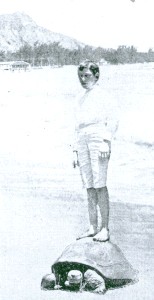 |
|
Between rocky
walls, a narrow stream of water comes pouring down through a winding trough
of lava worn smooth by constant erosion.
A native sits
in the trough, the water behind him piles up in an instant, and he is propelled
forward at a seemingly breakneck speed.
In and out his
body winds between the rocks, now following serpentine curves, now - darting
straight ahead - then disappearing over the edge of a waterfall, emerging
a second later from the depths of the pool below, then shooting forward
into the next descending trough.
Shrieks of laughter
ascend from the young girls and they, too, seat themselves in the trough
of the sliding rock, shot over falls and down through rapids - all shrieking
and laughing with delight.
It seems a dangerous
sport, yet no one is hurt.
I determined to
try it.
Gingerly I seated
myself; the steep descent and jutting rocks before me made believe that
only the natives have solved the secret of avoiding them; I attempted to
rise, the water piling up behind me swept me forward feet foremost, and
so in a sitting position I shot in and out between the high rocks on either
side of me, and suddenly I was in the air.
Shot over a waterfall,
I landed in the pool below in a sitting position.
Then I was upset
forward, hurled into a narrow channel while my body glided over velvet
rock.
I went bumping
over stones and rocks in a cararact, took another fearful dive and landed
in smooth water in the midst of a circle of happy, laughing Fiji boys and
girls.
We climbed the
side of the gulch, retraced our steps and repeated the sport time and again.
Sometimes we went singly, sitting or lying down or feet foremost, some
of the more expert standing
on the slimy,
slippery bed of rock and keeping their balance as they sped along, until
carried over the fall and alighting feet downward in the pool below.
Sometimes three
or four of us went down together, the first with his feet outstretched
before him, the feet of the one behind under his arms, with his arms about
his waist so we formed a train that dashed at express speed between the
rock walls and is sent over the fall in a shrieking line of humanity that
becomes instantly disorganized as it strikes the water below.
Sport!
It is sport for
all the gods and goddesses of ancient or modern mythology.
The slide at Papasaia, four or five miles from Apia, is of course better ...
Page 661
... known to the
tourist than is the slide in Fiji.
I wandered out
one steamer day and found a picnic party of a number of tourists
and a dozen Samoan maids preparing for the great sport.
The men - some
of whom had brought their own wives - retired to a little native house
and donned their bathing suits - one attempted to adjust a native lava-lava
or loin cloth - with seeming success. The Samoan girls, as is their wont,
merely turned their backs, discarded all upper clothing and adjusted their
lava-lavas firmly.
Then the procession
wended its way down to the rock.
The men with
one accord paused before the rock; it , was thirty to forty feet high and
over its smooth perpendicular face trickled several broad ribbons of water.
One of the Samoan
girls sat upon the edge of the cliff, straightened her body and shot down,
descending into the deep pool at the base of the falls and rising from
the waters to shake her hair and laugh loudly - an invitation to the others
to follow.
One more venturesome
than the others did so.
He sat upon the
edge of the cliff, looked down, changed his mind, tried to get up, his
feet slipped from under him and the next moment I was shooting through
the air, my breath leaving my body; then there was a splash, a sensation
as though I would never come up above water again - a coughing and spluttering,
then a sound of laughter in my ears.
The momentary
thrill while falling those brief forty feet exceeds any sensation connected
with the water slide at Taviuni, but there it lasts for minutes, while
at Papasaia it is allover in a flash and a splash.
The tourist with self-adjusted lava-lava was the next to attempt the slide, or fall; we finally left him in the pool searching with his feet for his lava-lava and not daring to come out in the presence of the ladies.
The great sport
is, of course, to show the novice how it is done.
First a Samoan
girl, full of laughter, sits on the edge of the precipice - the victim
sits behind her: then an accomplice of the first girl sits behind him:
suddenly there is a closing up of the ranks and the three go down together
- the victim rises spluttering and bewildered, to the intense amusement
of all. Sometimes there is a curtain lecture waiting the victim as he crawls
out of the swimming pool.
I saw one roundly
lectured and marched away by an indignant wife who could not be made to
understand the simplicity of the native Samoan sports.
There are really
three slides at Papasaia: First, the man's slide, already described; then
a rod lower down the stream a little sliding drop of ten feet called the
children's slide; then a third a few yards further, a steep but not a perpendicular
drop, and this is the woman's slide.
The picnickers,
however, invariably begin with the sliding rock, and once the slide is
taken, the sport becomes thoroughly enjoyable and the visiting parties
that frequent Papasaia keep its fame before the world, and spread it still
further abroad with every year that passes.
N early all the
South Sea Island sports are associated with the water - for, as in Samoa,
the villages are usually built directly upon the seashore, or upon the
banks of short navigable streams.
Even in Fiji
among tile mountain tribes of the ...
Page 662
... two large
islands, the one great sport is shooting the rapids in canoes.
Some marvelous
records have been made in tiny canoes down these racing, raging mountain
torrents.
Near Levuku, the
old capital of Fiji, on the Island of Ovalau, I was introduced to the sport
of shooting sharks.
Near the town
is the ahbatoir - the blood from the cattle flows into the sea and at high
tide the sharks. attracted by the smell, come in droves - they swim within
a few feet of the shore and persons wading in water knee deep have had
their legs bitten off.
The sport is
to stand on the beach and shoot the sharks as they come sailing by.
There is a great
spluttering and throwing up of sand and as often as not Mr. Shark makes
his escape into deep water.
It is, however,
more exciting sport, to my mind, than any shark hunting expedition I took
part in with the Hawaiians.
In Hawaii there
was a time when the native would leap overboard armed only with a sheath
knife and fight the largest sharks that frequent the waters about the islands.
Nowadays, shark
hunting is done by steam lauches.
A white horse
that has served its day is killed and anchored in shallow water until it
is quite ripe, then some morning it is attached to the launch by ropes
and towed out into deep water.
The gleaming
white of the carcass attracts the sharks, and they come - first one solitary
fellow; he sniffs about the bait and goes away, soon to return, followed
bv other sharks.
Absolute silence
is enjoined on the launch and the sharks take a bite at the bait, then
swim quickly away.
Soon, however,
the taste of blood is in their mouth and they return - now they attack
the carcass ravenously.
Slowly the man
on the launch hauls in on the bait line and silently the harpooner takes
his position. As the carcass and the sharks come within striking distance
he lets fly, and then everyone is at liberty to pepper away with rifles
and revolvers; but the sharks are off, even the one that is harpooned,
but if the line holds, he is soon wearied out and brought alongside to
be despatched.
If he should
escape, there is no need to go shark hunting in that vincinity the next
day.
It is usually
the pearl fishers of the South Sea Islands who find real sport in shark
fighting nowdays in the APacific, and rtey fight when only attacked.
At no time is
shark hunting under the sea a sport for the white man.
In the harbor
of Apia the natives are fearless, but those ashore have witnessed horrible
accidents to white swimmers.
Not so long ago
one of the young middies of a German man-of-war, taking his regular swimming
lesson, with a rope about his waist, was attacked, the shark leaping out
of the water after him when he was being hauled up.
The Samoans go
out, sometimes in light canoes, far from land, and remain over night in
their search for the shark.
They carry only
a line of sennit, (made from the fibre of the cocoanut husk, and strong
beyond belief) at the end of which they make a running noose, and a bit
of bait which they dangle before the loop in the line.
Soon Mr. Shark
comes leisurely alongside and begins to sniff at the bait.
If he does not
put his head in the noose, one of the natives may slip it over his tail,
and then there is a race to sea.
Usually, however,
the shark puts his head through the noose,which is tightened about his
neck, there is a brief struggle before he is hauled alonside where a sharp
blow from a club upon his snout gives him his last quietus.
Seldom is it
that the Samoan permit a shark to escape; he will even plunge into the
water to fight one that is in danger of slipping out of the noose.
Everywhere in
the South Seas it was my delight to watch the islanders spear fish, and
borrowing their long reeds tipped with a single needle of steel, seek to
emulate their remarkable feats of skill - but with little success.
In the clear
limpid waters about the coral reefs. fish of gorgeous color may be seen
swimming fathoms below the surface: in the shallower waters smaller fish
are to be found, but there is none too small for the spear of the South
Sea Island fisherman.
A single minnow, flitting by, will be ...
Page 663
... impaled unerringly
- in fact, even the small bovs are expert at this and spend much of their
time ashore spearing small round sticks that are thrown along over the
grass.
It is a great
sport, fish spearing, once the eye is trained and you learn the knack,
but somehow I was only successful when I cast a five or six pronged spear
into a school of fish that happened to be disporting themselves near the
surface of the water - then I was sometimes successful.
Spearing fish
in the South Seas is not the most successful sport to be indulged in by
the amateur.
There is one South
Sea Island sport, however, that the amateur may become proficient in almost
at once - and that is turtle riding in the lagoons.
Every native
chief keeps his private turtle pond; in fact turtle meat is forbidden to
the common people, unless especially presented to them by the chief.
All turtles caught
in the South Seas belong to the local chief, every white man of course,
ranking with a chief.
Put on your bathing
suit and plunge into the lagoon where the turtles are kept within bound,
seize a large one with the left hand just where the shell overlaps the
head, place the left knee and the right and firmly on the turtIe's back
and let the right leg remain stretched straight out behind you to steer
with.
The turtle will
begin at once to make an attempt to escape.
If he tries to
dive lean back on your steed and pull upward with the left hand - this
keeps his head above water - if your steed evinces a desire to go to the
right, throw your loose leg to the left, until he is headed again in the
direction you wish him to go.
Within a few
moments you have mastered the rudiments of ttlrtle riding - then for the
race - some of the native boys will gladly join the sport, and for so long
as you care to keep it up, you may race your steed around or across the
lagoon at will.
The speed of
these animals through the water will astonish you, and it is highly proable
that your turtle will be thoroughly exhausted before you tire of the sport.
Turtle races
are safe, for a little knowledge of the reach of the sharp hawk-like beak,
will teach you the narrow circle that is "tabu," that is "sacred" to his
lordship the turtle, and "forbidden" to you.
It is safe to
catch your turtle by the overlapping shell just above his head, and the
rest is easy; mount quickly and a way you go - guide so that there is no
collision with those with whom you race, and in a little while you may
become as proficient a turtle jockey as the natives themselves.
An American,
I believe, was the first white man to bring turtle racing within the realm
of the sports of the "Palangi" (white man) and for this he should have
the thanks of everyone who visits the South Seas and enjoys the thrills
of a sport that is new to him.
No sports in the
South Seas!
Why the South
Sea Islanders are so accustomed to aquatic and other sports that they have
become a part of their everyday life, so that when you inform them they
are sportsmen they are as surprised as Moliere's tradesman who at the age
of fifty, learned to his astonishment, that he had been speaking prose
all his life.
The South Sea
is the natural home of him who lives out-door sports.
(Photograph,
page 663, House and gardens.)
(Untitled).
|
The Mid-Pacific Magazine Published by Alexander Hume Ford, Honolulu, Territory of Hawaii, Volume 1, Number 6, June,1911 |

| home | catalogue | history | references | appendix |